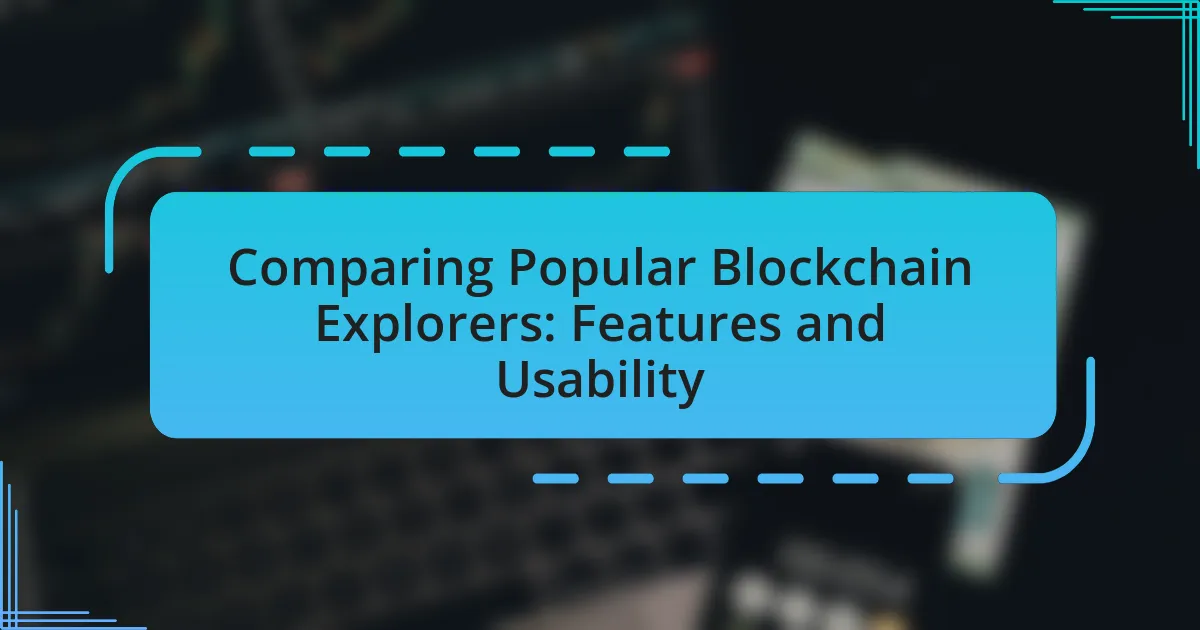The article focuses on blockchain technology, a decentralized digital ledger that securely records transactions across multiple computers. It highlights the importance of blockchain in providing transparency, security, and fraud reduction, while explaining its key components such as decentralization, consensus mechanisms, and smart contracts. The article categorizes blockchains into public, private, and consortium types, detailing their distinct features, advantages, and use cases. Additionally, it discusses the role of blockchain explorers in enhancing transparency and facilitating transaction tracking, along with best practices for their effective use. Overall, the article provides a comprehensive overview of blockchain technology and its applications, emphasizing the significance of understanding different blockchain types and the tools available for navigating them.
What is Blockchain and Why is it Important?
Blockchain is a decentralized digital ledger technology that securely records transactions across multiple computers, ensuring that the recorded data cannot be altered retroactively without the consensus of the network. Its importance lies in its ability to provide transparency, enhance security, and reduce fraud, as each transaction is encrypted and linked to the previous one, forming a chain of blocks. This structure not only fosters trust among users but also enables various applications, such as cryptocurrencies, supply chain management, and smart contracts, which rely on its immutable nature to function effectively.
How does Blockchain technology function?
Blockchain technology functions as a decentralized digital ledger that records transactions across multiple computers in a way that ensures the security and integrity of the data. Each transaction is grouped into a block, which is then linked to the previous block, forming a chain. This structure prevents any alteration of the data without consensus from the network participants, as changing one block would require altering all subsequent blocks, which is computationally impractical. The use of cryptographic hashing ensures that each block is securely connected to its predecessor, maintaining the integrity of the entire chain. Additionally, consensus mechanisms, such as Proof of Work or Proof of Stake, validate transactions and add new blocks to the chain, further enhancing security and trust within the network.
What are the key components of Blockchain technology?
The key components of Blockchain technology are decentralization, transparency, immutability, consensus mechanisms, and smart contracts. Decentralization ensures that no single entity controls the entire network, allowing for distributed control among participants. Transparency allows all transactions to be visible to network participants, fostering trust. Immutability guarantees that once data is recorded on the blockchain, it cannot be altered or deleted, ensuring data integrity. Consensus mechanisms, such as Proof of Work or Proof of Stake, are protocols that validate transactions and maintain the network’s integrity. Smart contracts are self-executing contracts with the terms of the agreement directly written into code, enabling automated and trustless transactions. These components collectively enhance the security, efficiency, and reliability of blockchain systems.
How does decentralization enhance Blockchain security?
Decentralization enhances blockchain security by distributing control and data across a network of nodes, making it significantly harder for any single entity to manipulate or compromise the system. In a decentralized blockchain, each participant maintains a copy of the entire ledger, which ensures that any attempt to alter transaction data would require consensus from a majority of nodes, thereby preventing fraudulent activities. This structure is supported by cryptographic techniques that secure data integrity and authenticity, as seen in Bitcoin’s use of the SHA-256 hashing algorithm, which makes it computationally infeasible to alter past transactions without detection.
What are the primary types of Blockchains?
The primary types of blockchains are public, private, and consortium blockchains. Public blockchains, such as Bitcoin and Ethereum, are open to anyone and allow for decentralized participation, ensuring transparency and security through consensus mechanisms like proof of work. Private blockchains, in contrast, are restricted to specific users and organizations, providing greater control and privacy, often utilized by enterprises for internal processes. Consortium blockchains represent a hybrid model where multiple organizations share control, enhancing collaboration while maintaining some level of privacy. These classifications are essential for understanding the varying applications and governance structures within blockchain technology.
What distinguishes public Blockchains from private Blockchains?
Public blockchains are decentralized and open to anyone, while private blockchains are centralized and restricted to a specific group of participants. Public blockchains, such as Bitcoin and Ethereum, allow anyone to join the network, validate transactions, and access the entire blockchain ledger. In contrast, private blockchains, like Hyperledger Fabric, require permission to access and typically involve a limited number of trusted entities that control the network. This fundamental difference in accessibility and governance shapes their use cases, with public blockchains often used for cryptocurrencies and decentralized applications, while private blockchains are favored for enterprise solutions requiring confidentiality and control.
How do consortium Blockchains operate?
Consortium blockchains operate through a collaborative model where multiple organizations share control over the network. In this structure, a predefined group of participants, often from related industries, validates transactions and maintains the blockchain, ensuring that no single entity has complete authority. This shared governance enhances trust among participants while allowing for faster transaction speeds and greater privacy compared to public blockchains. For instance, the Hyperledger Fabric framework exemplifies this model, enabling organizations to create permissioned networks tailored to their specific needs, thus demonstrating the effectiveness of consortium blockchains in facilitating secure and efficient collaboration.
What role do Blockchain explorers play?
Blockchain explorers serve as tools that allow users to view and analyze blockchain data. They provide a user-friendly interface to access information such as transaction history, block details, and wallet balances. By enabling users to track transactions in real-time, blockchain explorers enhance transparency and accountability within the blockchain ecosystem. For instance, Bitcoin blockchain explorers like Blockchair and Blockchain.com allow users to search for specific transactions using transaction IDs, thereby validating the integrity of the blockchain.
How do Blockchain explorers enhance transparency?
Blockchain explorers enhance transparency by providing real-time access to transaction data and blockchain activity. These tools allow users to view detailed information about transactions, including sender and receiver addresses, transaction amounts, and timestamps, which fosters accountability. For instance, Bitcoin blockchain explorers like Blockchair and Blockchain.com enable users to track the flow of funds and verify the legitimacy of transactions, thereby reducing the potential for fraud. This open access to data ensures that all transactions are publicly recorded and immutable, reinforcing trust in the blockchain system.
What features should a good Blockchain explorer have?
A good Blockchain explorer should have user-friendly navigation, comprehensive search functionality, real-time data updates, and detailed transaction information. User-friendly navigation allows users to easily access various blockchain data, while comprehensive search functionality enables users to find specific transactions, addresses, or blocks efficiently. Real-time data updates ensure that users receive the most current information, which is crucial for tracking transactions as they occur. Detailed transaction information, including timestamps, fees, and confirmations, provides users with a complete view of each transaction’s status and history. These features collectively enhance the usability and effectiveness of a Blockchain explorer.
How do Different Types of Blockchains Compare?
Different types of blockchains compare primarily based on their structure, accessibility, and consensus mechanisms. Public blockchains, such as Bitcoin and Ethereum, are open to anyone and utilize decentralized consensus, allowing for transparency and security but often facing scalability issues. Private blockchains, like Hyperledger, restrict access to a select group of participants, enhancing speed and privacy but sacrificing some decentralization. Consortium blockchains, which are governed by a group of organizations, balance the benefits of both public and private blockchains, offering a controlled environment while still allowing for some level of decentralization. Each type serves distinct use cases, with public blockchains being ideal for cryptocurrencies, private blockchains suited for enterprise solutions, and consortium blockchains fitting collaborative projects among businesses.
What are the advantages and disadvantages of public Blockchains?
Public blockchains offer transparency and decentralization, allowing anyone to participate in the network and verify transactions. This openness fosters trust among users, as all transactions are recorded on a public ledger that is immutable and accessible to anyone. However, public blockchains also face disadvantages, such as scalability issues and slower transaction speeds due to the need for consensus among a large number of participants. For instance, Bitcoin, a prominent public blockchain, can process only about seven transactions per second, which can lead to delays during peak usage times. Additionally, public blockchains are more susceptible to security risks, such as 51% attacks, where a single entity gains control over the majority of the network’s mining power, potentially compromising the integrity of the blockchain.
How do transaction speeds differ in public Blockchains?
Transaction speeds in public blockchains vary significantly based on their underlying technology and consensus mechanisms. For instance, Bitcoin processes approximately 7 transactions per second due to its Proof of Work consensus, while Ethereum can handle around 30 transactions per second. In contrast, newer blockchains like Solana boast speeds exceeding 65,000 transactions per second by utilizing a unique Proof of History mechanism. These differences arise from factors such as block size, block time, and the efficiency of the consensus algorithm, which directly impact how quickly transactions can be confirmed and added to the blockchain.
What security challenges do public Blockchains face?
Public blockchains face several security challenges, including susceptibility to 51% attacks, smart contract vulnerabilities, and privacy issues. A 51% attack occurs when a single entity gains control of more than half of the network’s mining power, allowing them to manipulate transactions and double-spend coins. Additionally, smart contracts, which are self-executing contracts with the terms directly written into code, can contain bugs or vulnerabilities that hackers can exploit, leading to significant financial losses. Furthermore, public blockchains often lack privacy features, making transaction details visible to anyone, which can expose users to targeted attacks or unwanted scrutiny. These challenges highlight the need for robust security measures and ongoing vigilance in the management of public blockchain networks.
What are the benefits of private Blockchains for businesses?
Private blockchains offer businesses enhanced security, improved privacy, and greater control over data management. These blockchains restrict access to authorized participants, which minimizes the risk of data breaches and ensures that sensitive information remains confidential. Additionally, private blockchains allow businesses to customize their governance models and consensus mechanisms, enabling faster transaction speeds and reduced costs compared to public blockchains. According to a report by Deloitte, 40% of organizations are considering private blockchain solutions for their ability to streamline operations and enhance data integrity.
How do private Blockchains improve data privacy?
Private blockchains improve data privacy by restricting access to the network and allowing only authorized participants to view and interact with the data. This controlled access ensures that sensitive information is not exposed to the public, unlike public blockchains where all transactions are visible to anyone. Additionally, private blockchains often implement advanced encryption techniques and permissioned access controls, further enhancing data security and confidentiality. For instance, organizations can define specific roles and permissions for users, ensuring that only those with the necessary clearance can access particular data sets, thereby minimizing the risk of unauthorized access and data breaches.
What industries are adopting private Blockchains?
Private blockchains are being adopted by industries such as finance, healthcare, supply chain management, and government. In finance, institutions utilize private blockchains for secure transactions and efficient settlement processes. Healthcare organizations implement private blockchains to manage patient records while ensuring data privacy and compliance with regulations. Supply chain management benefits from private blockchains by enhancing traceability and transparency in product sourcing and logistics. Governments are exploring private blockchains for secure voting systems and identity management, improving trust and efficiency in public services.
How do consortium Blockchains facilitate collaboration?
Consortium blockchains facilitate collaboration by allowing a group of pre-selected organizations to jointly manage the blockchain network, ensuring shared governance and decision-making. This structure promotes trust among participants, as each member has a stake in the network’s operation and security, which encourages cooperation and data sharing. For instance, in supply chain management, consortium blockchains enable companies to track products collaboratively, enhancing transparency and efficiency while reducing fraud. The shared control model also allows for faster consensus mechanisms compared to public blockchains, as fewer nodes are involved in the validation process, leading to quicker transaction times and improved collaboration outcomes.
What are the governance models used in consortium Blockchains?
Consortium blockchains typically utilize governance models that include centralized governance, decentralized governance, and hybrid governance. Centralized governance involves a single organization or a small group of organizations making decisions, which can streamline processes but may reduce transparency. Decentralized governance distributes decision-making across all participants, enhancing transparency and inclusivity but potentially slowing down consensus. Hybrid governance combines elements of both models, allowing for efficient decision-making while maintaining a level of decentralization. These models are essential for establishing rules, managing changes, and ensuring compliance within consortium blockchains, as evidenced by various implementations in industries such as finance and supply chain management.
How do consortium Blockchains differ from public and private Blockchains?
Consortium blockchains differ from public and private blockchains primarily in their governance and access control. Consortium blockchains are governed by a group of organizations, allowing for a semi-decentralized approach where multiple entities share control, while public blockchains are open to anyone and fully decentralized, and private blockchains are controlled by a single organization with restricted access. This governance structure in consortium blockchains enables a balance between transparency and privacy, as participating organizations can collaborate while maintaining some level of confidentiality, unlike public blockchains that prioritize openness and private blockchains that prioritize control.
What Practical Insights Can Be Gained from Using Blockchain Explorers?
Using blockchain explorers provides practical insights such as transaction verification, network activity analysis, and wallet balance tracking. Transaction verification allows users to confirm the status and details of transactions on the blockchain, ensuring transparency and trust. Network activity analysis reveals trends in transaction volume and user engagement, which can inform investment decisions or network health assessments. Wallet balance tracking enables users to monitor their cryptocurrency holdings in real-time, enhancing financial management. These functionalities are supported by the inherent transparency of blockchain technology, where all transactions are publicly recorded and accessible through explorers.
How can users effectively utilize Blockchain explorers?
Users can effectively utilize Blockchain explorers by searching for transaction details, wallet addresses, and block information to gain insights into blockchain activity. By entering specific transaction IDs or wallet addresses into the explorer, users can view transaction histories, confirmation statuses, and associated fees, which helps in tracking the movement of assets. Additionally, users can analyze block data to understand network performance and transaction throughput, as explorers often provide metrics such as average block times and total transactions per second. This functionality is crucial for verifying transactions and ensuring transparency in blockchain operations.
What are the best practices for tracking transactions on a Blockchain?
The best practices for tracking transactions on a blockchain include using reliable blockchain explorers, ensuring transaction IDs are accurately recorded, and monitoring confirmations for security. Reliable blockchain explorers, such as Etherscan for Ethereum or Blockchair for Bitcoin, provide real-time data on transaction status and history. Accurately recording transaction IDs is crucial, as these unique identifiers allow users to trace specific transactions. Monitoring confirmations is essential because a higher number of confirmations typically indicates greater security and finality of the transaction, reducing the risk of double-spending or fraud.
How can Blockchain explorers assist in troubleshooting issues?
Blockchain explorers assist in troubleshooting issues by providing real-time access to blockchain data, allowing users to verify transactions, track block confirmations, and identify discrepancies. These tools enable users to search for specific transaction IDs, wallet addresses, or block numbers, facilitating the identification of errors or delays in transaction processing. For instance, if a transaction appears to be stuck, a blockchain explorer can show its status, including whether it has been confirmed or is still pending, thus helping users understand the issue. Additionally, explorers often display detailed information about transaction fees and timestamps, which can further aid in diagnosing problems related to network congestion or insufficient fees.
What common challenges do users face with Blockchain explorers?
Users commonly face challenges with Blockchain explorers, including usability issues, data accuracy, and limited functionality. Usability issues arise from complex interfaces that can confuse users, particularly those unfamiliar with blockchain technology. Data accuracy is a concern, as discrepancies may exist between different explorers due to variations in how they index and display blockchain data. Limited functionality can hinder users, as some explorers may not support advanced features like transaction tracking or multi-chain support, restricting their ability to fully utilize the blockchain’s capabilities.
How can users overcome difficulties in navigating Blockchain explorers?
Users can overcome difficulties in navigating Blockchain explorers by utilizing user-friendly interfaces and educational resources. Many Blockchain explorers offer intuitive designs that simplify the search for transactions, blocks, and addresses, making it easier for users to find the information they need. Additionally, users can access tutorials, FAQs, and community forums that provide guidance on how to effectively use these tools. For instance, platforms like Etherscan and Blockchair include comprehensive help sections that explain features and functionalities, enhancing user understanding and navigation skills.
What resources are available for learning more about Blockchain explorers?
Resources for learning about Blockchain explorers include online tutorials, documentation from specific blockchain projects, and educational platforms. Websites like Blockgeeks and Coursera offer courses that explain how to use blockchain explorers effectively. Additionally, the official documentation of popular blockchain networks, such as Bitcoin and Ethereum, provides detailed guides on their respective explorers. Forums and community discussions on platforms like Reddit and Stack Exchange also serve as valuable resources for practical insights and user experiences related to blockchain explorers.





